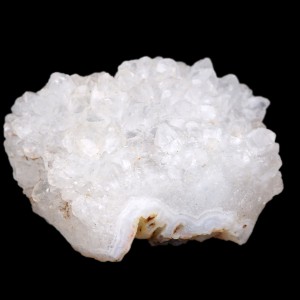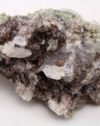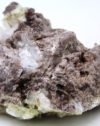HISTORY, NAME, LOCALITIES: Anandite was discovered in Sri Lanka (formerly Ceylon) and recognized as a mineral species in 1967. It is named for Ananda Kentish Coomaraswamy, the first director of the Mineral Survey of Ceylon. Anandite is a rare mineral with important sources only in Sri Lanka and the United States (California, New Jersey).
MINERALOGY, PROPERTIES, OCCURRENCE: Anandite [basic barium iron sulfosilicate, BaFe4Si3O10S(OH)], pronounced ah-NAHN-dite, is a rare phyllosilicate and a member of the mica group of minerals. It crystallizes in the monoclinic system and occurs in flexible, flattened, sheet-like, hexagonal crystals and in massive form. Anandite has a Mohs hardness of 3.0-4.0, perfect cleavage in one direction, a specific gravity of 3.94, and a vitreous luster. Sub-translucent to opaque, it is generally black in color with subtle hints of green and brown. Anandite occurs primarily in banded formations of magnetite iron ores in association with such minerals as pyrite, magnetite, and barite.
METAPHYSICAL PROPERTIES, LORE, USES: Metaphysical practitioners believe that anandite is similar to the mica-group mineral muscovite and protects against negative energies, balances earth energies, and shields one against jealousy, anger, and violence. Because of its rarity, anandite has no technological or gemstone uses.
COLLECTORS’ INFORMATION: Anandite is collected for is rarity and unusual chemistry as a sulfur- and barium-bearing, mica-group mineral.





 Axinite #10
Axinite #10  Axinite #8
Axinite #8